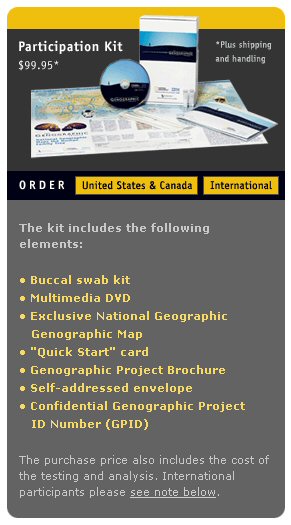Paticipate In the Genographic Project
 The National Geographic Society has launched the Genographic Project, a five-year effort to understand the human journey—where we came from and how we got to where we live today. This unprecedented effort will map humanity's genetic journey through the ages.
The National Geographic Society has launched the Genographic Project, a five-year effort to understand the human journey—where we came from and how we got to where we live today. This unprecedented effort will map humanity's genetic journey through the ages.How did we, each of us, end up where we are? Why do we appear in such a wide array of different colors and features? Such questions are even more amazing in light of genetic evidence that we are all related—descended from a common African ancestor who lived only 60,000 years ago.
"The greatest history book ever written is the one hidden in our DNA." Though eons have passed, the full story remains clearly written in our genes—if only we can read it. With your help, the Genographic Project can.
Our genes allow us to chart the ancient human migrations from Africa across the continents. Through one path, we can see living evidence of an ancient African trek, through India, to populate even isolated Australia.
But time is short. In a shrinking world, mixing populations are scrambling genetic signals. The key to this puzzle is acquiring genetic samples from the world's remaining indigenous peoples whose ethnic and genetic identities are isolated.
That's why the Genographic Project has established ten research laboratories around the globe. Scientists are visiting Earth's remote regions in a comprehensive effort to complete the planet's genetic atlas.
But the project doesn't just need genetic information from Inuit and San Bushmen— yours is needed as well. To fully complete the picture the pool of genetic samples must be greatly expanded from around the world. If you choose to participate and add your data to the global research database, you'll help to delineate our common genetic tree, giving detailed shape to its many twigs and branches.
Together we can tell the ancient story of our shared human journey.
Public participation, including yours, is critical to the Genographic Project's success. Here's how you can get involved:
Purchasing a Public Participation Kit will fund important research around the world—and open the door to the ancient past of your own genetic background.
With a simple and painless cheek swab you can sample your own DNA. You'll submit the sample through our secure, private, and completely anonymous system, then log on to the project Web site to track your personal results online.
This is not a genealogy test and you won't learn about your great grandparents. You will learn, however, of your deep ancestry, the ancient genetic journeys and physical travels of your distant relatives.
To insure total anonymity you will be identified at all times only by your kit number, not by your name. There is no record, no database that links test results with the names of their contributors. If you lose the kit number there will be no way to access your genetic results.
As your own genetic ancestry is revealed you'll also see worldwide samples map humankind's shared genetic background around the world and through the ages.
If you'd like to contribute your own results to the project's global database you'll be asked to answer a dozen "phenotyping" questions that will help place your DNA in cultural context.
This process is optional and completely anonymous, but it's also important. Each of us has a part in the ancient story of humankind's genetic journey. Together we can tell the whole story before it's too late. Order a Kit.
The Participation Kit costs U.S. $99.95 (plus shipping and handling and tax if applicable). The kit includes:
1. DVD with a Genographic Project overview hosted by Dr. Spencer Wells, visual instructions on how to collect a DNA sample using a cheek scraper, and a bonus feature program: the National Geographic Channel/PBS production The Journey of Man.
2. Exclusive National Geographic map illustrating human migratory history and created especially for the launch of the Genographic Project.
3. Buccal swab kit, instructions, and a self-addressed envelope in which to return your cheek swab sample.
4. Detailed brochure about the Genographic Project, featuring stunning National Geographic photography
5. Confidential Genographic Project ID # (GPID) to anonymously access your results at this Web site
The purchase price also includes the cost of the testing and analysis—an expensive process—that will take place once your sample is sent in.



0 Comments:
Post a Comment
<< Home